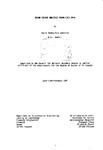OCEAN COLOUR ANALYSIS USING CZCS DATA
| dc.contributor.author | Lawrence, David Hawkesford | |
| dc.contributor.other | School of Engineering, Computing and Mathematics | en_US |
| dc.date.accessioned | 2013-09-16T09:31:58Z | |
| dc.date.available | 2013-09-16T09:31:58Z | |
| dc.date.issued | 1987 | |
| dc.identifier | NOT AVAILABLE | en_US |
| dc.identifier.uri | http://hdl.handle.net/10026.1/1731 | |
| dc.description.abstract |
A low-cost image processor has been designed and built to provide a system suitable for investigating the quantitative mapping of phytoplankton patchiness using Nimbus-7 CZCS satellite images. The processor design was based upon a Motorola 68000 computer linked to a 768x512x8 bit imagestore. High resolution images were input from the CZCS CCT via a 40 Mbyte tape transport. The system had the novel capability for real time linear and non-linear operations upon images on a pixel-by-pixel basis and fast evaluation (<10 seconds) of retrieval algorithms involving narrow band images. Software was developed to manage the images in the following ways: high emphasis filtering, edge detection, contrast stretch routines, rectification, and pseudo colour routines for grey-level colouring prior to display of the processed image on a double resolution colour monitor. Initial testing of the instrument was via multiband aerial photographs input through a broadcast quality camera, although the major analysis was carried out on CZCS data. Software was developed to correct the measured radiances at the satellite for atmospheric effects, thus giving values of the water-leaving radiances. In the correlation studies the sea truth was obtained in the form of chlorophyll concentrations determined during UOR surveys of the English Channel. Both high and low chlorophyll concentration scenes were analysed. The algorithm testing involved ratioing the radiances from the various narrow bands and incorporating them in quantitative expressions which were linear, logarithmic and polynomial. Four different images were investigated and the results showed that the observed chlorophyll concentrations were best correlated with water-leaving radiances through a linear expression. The spectral Information was also analysed with a clustering-technique to identify patches of chlorophyll of varying concentrations. The work shows that digital image processing can be used in conjunction with retrieval algorithms to provide real time detection of phytoplankton fronts in coastal waters . | |
| dc.description.sponsorship | Institute for Marine Environmental Research, Prospect Place, Plymouth, Devon | en_US |
| dc.language.iso | en | en_US |
| dc.publisher | University of Plymouth | en_US |
| dc.title | OCEAN COLOUR ANALYSIS USING CZCS DATA | en_US |
| dc.type | Thesis | |
| plymouth.version | Full version | en_US |
| dc.identifier.doi | http://dx.doi.org/10.24382/1470 | |
| dc.identifier.doi | http://dx.doi.org/10.24382/1470 |
Files in this item
This item appears in the following Collection(s)
-
01 Research Theses Main Collection
Research Theses Main


